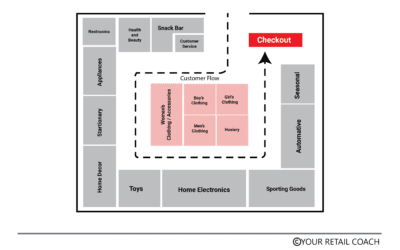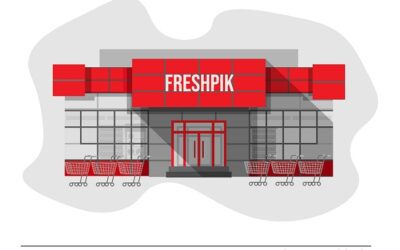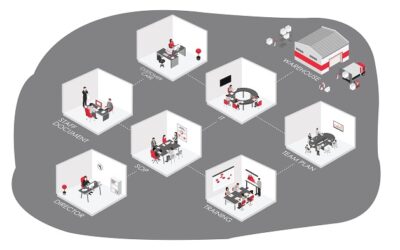Convenience Stores (Gas Station, Metro Station, Airport)
Meaning of Convenience Store and How it is Different
In retailing, there is a unique market spot for on-the-move, emergency, and/or unplanned purchases of routine consumer products. This spot is occupied by convenience stores. Ideal locations for convenience stores are transit hubs like airports, gas stations, bus terminals, etc. It is uncommon for customers to visit convenience stores for making any planned, routine, and/or big-ticket purchases. Convenience stores are meant to fulfil quick needs. These needs are realised or emerge suddenly. The creation of need and the purchase decision is quick.
Because of these unique functionalities i.e. to be able to fulfil unplanned, quick, and emergency needs, most convenience stores remain open for extended hours. Convenience stores also maintain extensive merchandise. These are like value-added or premium services and hence, price discounts are rare in convenience stores.
Customers visit routine grocery or departmental stores with an element of planned certainty. For example, it is common among households to assess consumption patterns and plan purchases. The same does not hold for convenience stores. The elements of planning and certainty are both missing when buying from convenience stores except when that is consciously done. For example, while filling gas, it may be suddenly remembered that there is no milk at home. This realisation could also be triggered by seeing a convenience store or any other relevant visual trigger.
Convenience Stores in Transit Hubs as a Business Opportunity
Convenience stores in transit hubs like airports, gas stations, metro stations, or bus terminals are not a new phenomenon. But now the business model is becoming popular and the reasons have stayed the same.
Buying On-The-Move
One of the leading reasons why convenience stores are popular is because they let customers buy while commuting or travelling. As discussed earlier, this presents a unique market opportunity or rather in consumer behaviour. This behaviour is recalling things needed back at home while commuting or travelling. Convenience stores in transit hubs are a common place for visual triggers. The scope of expanded decision-making is zero to none which means sales from a business viewpoint.
Wrapping up Small or Forgotten Needs
Customers do not always get everything covered from their routine grocery stores, departmental stores or even supermarkets. Or sometimes they forget to register goods needed on their shopping lists. Convenience stores are an easy and suitable alternative to wrap up such shopping needs.
But does it work for transit hubs? In any busy or cosmopolitan city, a significant number of people travel and commute long distances every day. And people do forget to plan their purchases properly or feel the urge or need to buy something en route.
Comprehensive Merchandising
Another feature of convenience stores is that these stores are required to maintain a wide merchandising portfolio. There may not be an option of bulk buying but nearly every conceivable consumer product is found in good convenience stores. From safety pins to perfumes, maintaining a comprehensive merchandising portfolio is essential for convenience stores. This also works well with customer segments that have uncommon and unique requirements (chefs/food enthusiasts for example).
The ability to cover a wide range of needs makes convenience stores stand out in the crowd of routine grocery stores. This merchandising uniqueness makes convenience stores an attractive spot to buy products which are not available in the local, residential stores. Customers can even plan their purchases if they know in advance if any convenience store in their travel route keeps those products.
Untimely Needs
Unplanned demand was briefly discussed earlier. Untimely needs are an example of unplanned needs or purchasing. And it is quite common to have an untimely need while travelling or commuting. A suitable example from recent history would be masks and sanitisers. Sometimes the masks get damaged or people run out of their pocket sanitisers. Convenience stores come to the rescue for such untimely needs. While the use of masks and sanitisers is receding, there are plenty of other products (or their packaging sizes) which fit into the category of untimely needs.
Tie-Ups
Convenience stores often tie up with filling stations. It is a mutually-beneficial business relationship for both sides. In such tie-ups, convenience stores save on real estate and get access to a moving stream of potential customers. Filling stations, by sharing any unused space, make better use of their real estate resource and also enhance the possibility of gaining more customers attracted due to the presence of a convenience store in the same premise.
Convenience stores are a relatively new concept and cater to urban markets. These stores tend to be highly modernised with eye-catching layouts, planograms, and visual appearances. The wide merchandising covers unique brands and products. In addition to the element of utility, convenience stores reflect the demands of uber, cosmopolitan cities.
Convenience stores enjoy an advantage when it comes to promotions. They know where customers are – probably better than any other business. It becomes easy for them to identify the physical or digital touchpoints for advertising which often are trains and metro stations, buses and bus stands, highways to airports, websites and apps of hotels and travel agencies, etc.
Challenges in Transit Retailing or Travel Retailing
Achieving accuracy in demand forecasting
Convenience stores in transit hubs encounter several challenges in achieving precision in demand forecasting. One of the biggest challenges is the dynamic nature of demand in travel-based purchasing. And since convenience stores maintain extensive merchandising (even in limited quantities), the risk of many products not getting sold always remains high. Another problem area is the shortage of external data for analytics. Because purchasing in convenience stores often takes place in unplanned ways, online search activities are limited creating a scarcity of data for use in demand analytics.
Attracting Customers
Every passenger is a potential customer and yet no one may buy anything. Convenience stores are dependent on the need for the realisation of customers. The time window for this to happen is very narrow.
Talking about convenience stores in airports and metro stations, products are priced relatively higher or no discounts are offered. Customers who are aware of this would avoid buying except in dire situations. Routine passengers would rather plan their purchases.
High Rentals
Like in the case of any other rented property, the rentals for commercial space in transit hubs are also subject to annual or periodical hikes. While rents keep increasing, the dimensions of space remain the same. This increases the commercial burden of businesses every time there are rental hikes. If this increase in rent expenditure does not get compensated with a proportionate or similar increase in revenue, it begins to reflect negatively on financial statements. The same fundamental applies to other operating expenses as well.
Longer Replenishment Time
Convenience stores in transit hubs are subject to security rules and regulations laid down by concerned authorities. The inventory that enters the premises must pass through stringent security checks and screens. This slows down the stock replenishment operations of stores. Businesses have to initiate their procurement processes keeping this time requirement in mind. This slowdown also affects the ability of stores to make quick merchandising adjustments.
Limited Space
With limited space, convenience stores have very little room to play with their merchandising skills. Adding to the woes, some stores do not even have additional space for stocking. Limited stocking abilities of a store affect the variety of goods it can offer to its customers. This makes transit retailing more challenging for stores with small spaces.
The Pain of Returns and Refunds
After passengers leave a transit hub, the process of return and refund becomes a slow and challenging process for both retailers and customers. And in the case of airports, thinking of returns and refunds is nothing short of intimidation. Most retailers make it clear upfront that returns and refunds may not be possible. This whole thing is a major discouragement from customers’ perspective.
Longer Working Hours
There are transit hubs that function 24×7 for public convenience and meeting consumer demand. And many convenience stores in such places try to imitate the same routine. Such routines mean shift-based working that is stressful and exhausting for both business owners and employees.
Longer Onboarding Time
Working inside a transit hub like an airport is subject to stringent rules and regulations. In addition to the in-house checks and measures, employers also have to adhere to the protocols and standards laid down by concerned authorities. So, recruiting and onboarding take longer than usual for employees whose work location involves a transit hub.
Why YRC
YRC is a boutique retail and eCommerce consulting brand specialising in business management and business growth & expansion. Having worked with more than 500 clients in 25+ verticals, YRC has emerged as an emerging global brand. Our services and solutions are designed and carried out by a team of expert retail and eCommerce consultants with diversified professional exposure and experience. Our working is directed by demonstrated principles and processes. In transit retailing, startups and existing businesses can benefit from our broad range of services as per suitability and exclusive business requirements.
In business model development, we assist clients in identifying and developing robust, sustainable, and unique value propositions. The entire value chain is mapped detailing the best way to create and deliver the value propositions to the target segments.
In financial and commercial planning, we crunch the numbers in the form of budgets and projections required to pull off business ideas. The assessments cover demand forecasts, projections of sales and revenue, CAPEX and OPEX requirements, inventory and procurement planning, estimated profit and loss statements, ROI and break-even analysis, etc.
One of the major challenges in transit and travel retailing is space optimisation without compromising on the bigger marketing goals and CX objectives. In layout planning, we have an extensive array of proven solutions customisable to fit unique requirements and specifications. Implementing proven and improvised layout plans help businesses adopt long-lasting solutions in a short span of time.
Robust operations planning is vital for all businesses and convenience stores are no exception. We use SOPs in mapping and defining business processes. It helps owners of convenience stores focus on bigger business goals like customer acquisition and retention and other marketing endeavours. SOP development & implementation assistance is one of our flagship services.
To know more about YRC’s retail consulting services or if you want any business-related query on travel and transit retailing addressed by one of our expert retail consultants, drop us your contact coordinates and somebody from the team will reach out to you.
Let’s Talk!
FAQs
How to start a convenience store in a transit hub?
Some of the important steps in starting a convenience store are:
- Business idea validation,
- Formation of the core team,
- Business model development,
- Market research,
- Locational analysis,
- Formulation of functional strategies
- Operations planning,
- Business plan development including financial and commercial planning
- Layout planning
- Understanding of and adherence to the governing laws and rules and regulations
What are the challenges in transit retailing?
Here are some of the challenges often faced by business owners in transit or travel retailing:
Difficulties in making precise demand forecasting: Travel-based purchasing is unpredictable when it comes to establishing demand patterns. There is also a shortage of external data for analytics.
Difficulties in attracting customers: Every passenger is a potential customer and yet there may be no purchases.
High Rentals: Without an increase in revenue or space for more goods, annual rental hikes increase the commercial burden of convenience stores located in transit hubs.
Longer Replenishment Time: Stringent security checks and screens applicable in transit hubs slow down the stock replenishment operations of convenience stores located within.
Limited Space: With limited space, convenience stores in transit hubs have very little room for quick variations in merchandising or even stocking in advance.
Difficulties in Returns and Refunds: After passengers leave a transit hub, the process of return and refund becomes a distant and challenging process for both retailers and customers.
Can I start a convenience store with a minimalist space?
No space is small if rightly used. The solution is layout planning for convenience stores. One of the biggest hurdles in transit or travel retailing is space optimisation without losing the connection with bigger marketing goals and CX objectives. The access to proven and improvised layout plans help business owners quickly adopt effective solutions.
Related Blogs
Retail Store Layout Strategy: What to Consider and How to Plan
Why Store Layout Matters in Retail The layout of a retail store carries several internal and external business implications. Layout is an important physical aspect of branding efforts. It creates an opportunity to create the desired atmosphere in stores thereby...
Reliance Gourmet Supermarket – “Freshpik” Case Study
The fifth-largest and preferred retail destination globally, the Indian retail industry is one of the fastest-growing segments in the world. India is experiencing unprecedented growth with retail development taking place not just in major cities and metros, but also...
How to Organize & Grow Supermarket / Hypermarket
Already running a supermarket store and wondering how to scale it further? Are you contemplating what should be your next steps to accomplish your vision to organize and manage multiple stores? If this is what you are looking for, then you are in the right place. Your...





We work only for Visionaries.